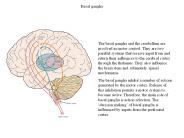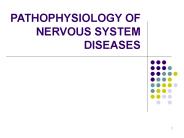Causes Of Basal Ganglia Disease PowerPoint PPT Presentations
All Time
Recommended
Basal ganglia disease refers to a group of physical dysfunctions that occur when the group of nuclei in the brain known as the basal ganglia fail to properly initiate movements.
| PowerPoint PPT presentation | free to download
tremor, chorea (athetosis, ballism), myoclonus, tics, dystonia. Huntington's disease, Wilson's disease, essential tremor, focal and generalised dystonias ' ...
| PowerPoint PPT presentation | free to view
Basal ganglia The basal ganglia and the cerebellum may be viewed as key elements in two parallel reentrant systems that receive input from and return their influences ...
| PowerPoint PPT presentation | free to download
... provide the excitatory signals that balance out the large no. of the inhibitory signals transmitted specially by the dopamin, GABA & serotonin inhibitory ...
| PowerPoint PPT presentation | free to view
Motor Disease Alzheimer Disease
| PowerPoint PPT presentation | free to view
Functional Anatomy of the Basal Ganglia Sharif Taha, Ph.D. s.taha@utah.edu Department of Neurobiology and Anatomy ...
| PowerPoint PPT presentation | free to download
Basal ganglia disease refers to a group of physical dysfunctions that occur when the group of nuclei in the brain known as the basal ganglia fail to properly initiate movements.
| PowerPoint PPT presentation | free to download
Basal ganglia disease refers to a group of physical dysfunctions that occur when the group of nuclei in the brain known as the basal ganglia fail to properly initiate movements.
| PowerPoint PPT presentation | free to download
Figure 2: Wilson disease. T2-weighted MR image depicts bilaterally symmetric areas of abnormal T2 hypersignal in the thalamus, putamina and caudate nuclei.
| PowerPoint PPT presentation | free to download
Wilson s Disease, A Disease to know Abdulwahab Telmesani FRCPC,FAAP Faculty of Medicine and Medical Science Umm Al-Qura University Wilson s Disease Liver biopsy ...
| PowerPoint PPT presentation | free to view
Pakarian P, Rayegani SM, and Shahzadi S. (2004) Effect of Vim ... in Ia fibres (which are the afferent fibers of stretch reflexes) results in tremor cessation. ...
| PowerPoint PPT presentation | free to download
Parkinson’s disease (PD) is the second most common neurodegenerative disease after Alzheimer’s disease, affecting around 7.4 million people worldwide. It is caused by the progressive loss of dopamine-producing neurons in the substantia nigra within the basal ganglia.
| PowerPoint PPT presentation | free to download
Chronic and degenerative brain disorder Impairs muscle control, balance, and movement Causes the cells in substantia nigra (in the basal ganglia) to deteriorate Inhibits the brain’s ability to produce dopamine (the happy hormone)
| PowerPoint PPT presentation | free to download
If the basal ganglia are not working properly, as in Parkinson's disease ... of movement, stiffness and effort required to move a limb and, often, tremor. ...
| PowerPoint PPT presentation | free to download
Big Market Research has announced a new Report Package "Global Huntington's Disease Therapeutics Market -Size, Share, Trends, Forecast, Development, Situation, Future outlook, Potential" Get Complete Details At: http://www.bigmarketresearch.com/global-huntingtons-disease-therapeutics-2014-2018-market Huntington's disease is a progressive neurodegenerative disorder that can be inherited from one generation to another as an autosomal dominant trait. It arises due to genetically programmed degeneration of neurons in some parts of the brain such as basal ganglia and cerebral cortex. Enquire At: http://www.bigmarketresearch.com/report-enquiry/144058
| PowerPoint PPT presentation | free to download
Parkinson's Disease. The basal ganglia, through the action of dopamine, are ... Dopamine levels in the brain's substantia nigra do normally fall with ageing. ...
| PowerPoint PPT presentation | free to download
introduction to esophageal diseases
| PowerPoint PPT presentation | free to download
Nervous System Pathology Lecture 3: Cerebrovascular Disease and Seizure Disorders Alvin V. Terry, Jr., Ph.D. Associate Professor UGA College of Pharmacy
| PowerPoint PPT presentation | free to view
Big Market Research has announced a new Report Package "Global Huntington's Disease Therapeutics Market -Size, Share, Trends, Forecast, Development, Situation, Future outlook, Potential" Get Complete Details At: http://www.bigmarketresearch.com/global-huntingtons-disease-therapeutics-2014-2018-market Huntington's disease is a progressive neurodegenerative disorder that can be inherited from one generation to another as an autosomal dominant trait. It arises due to genetically programmed degeneration of neurons in some parts of the brain such as basal ganglia and cerebral cortex. Enquire At: http://www.bigmarketresearch.com/report-enquiry/144058
| PowerPoint PPT presentation | free to download
Vesiculobullous Diseases
| PowerPoint PPT presentation | free to view
basal ganglia (neurologic symptoms) Kayser-Fleischer green brown ring ... distended, friable, congested segment. perforation peritonitis ...
| PowerPoint PPT presentation | free to view
Title: Memory and learning Author: Michael Walker Last modified by: xp Created Date: 4/12/2005 4:36:56 AM Document presentation format: On-screen Show (4:3)
| PowerPoint PPT presentation | free to view
PARATHYROID GLAND DISEASES Primary hyperparathyroidism Hypoparathyroidism
| PowerPoint PPT presentation | free to view
PARATHYROID GLAND DISEASES Primary hyperparathyroidism Hypoparathyroidism
| PowerPoint PPT presentation | free to view
Cerevrovascular disease Dr. Basu MD Topic Cerebral (intracranial) hemorrhage Types Etiology Morphology Clinical features Intracranial hemorrhage: types Non traumatic ...
| PowerPoint PPT presentation | free to download
Neurodegenerative Diseases Gerianne R. Bliss, M.D. Chuck Hensley, R.Ph. Parkinson s Disease Resting tremor, rigidity, and bradykinesia Degeneration of dopaminergic ...
| PowerPoint PPT presentation | free to view
Multiple Sclerosis. Alzheimer's Disease. Creutzfeld-Jakob Disease. Seizure Disorders (Epilepsy) ... Multiple sclerosis. Scarred hardening (sclerosis) of myelin ...
| PowerPoint PPT presentation | free to view
Trisomy 21 (Down syndrome) most frequent - 1:700 births; parents have normal karyotype ... Trisomy 18 (Edwards syndrome) 1:8000. Trisomy 13 (Patau syndrome) 1:15000 ...
| PowerPoint PPT presentation | free to view
pathophysiology of nervous system diseases*
| PowerPoint PPT presentation | free to download
Patients usually unaware of rigidity but troubled with slowness ... Patient leans to affected side. Stage 1.5. One sided disease plus axial (waist) involvement ...
| PowerPoint PPT presentation | free to view
... designer drugs, repeated head injuries sustained from boxing and brain tumors ... Caffeine consumers who consume 5 cups per day. Management ...
| PowerPoint PPT presentation | free to view
Destruction of dopaminergic neurons in the pars compacta of the ... Increases intracellular iron that can. catalyze reactions to produce toxic-free radicals ...
| PowerPoint PPT presentation | free to view
The development of transgenic models, has been intensively used for ... If neurons are deprived of oxygen and the ATP stores drop, excess excitatory ...
| PowerPoint PPT presentation | free to download
Cytopathology A branch of pathology that deals with manifestations of disease ... BDNF's are pro-survival factors produced by the cortical neurons of the brain. ...
| PowerPoint PPT presentation | free to view
In 2000, 7 percent of those with AD were age 65-74, 53 percent ... Distinction between palliative and preventative. Current treatment is Donepezil (Aricept) ...
| PowerPoint PPT presentation | free to view
Exceeded only by Heart disease and Cancer ... condition in which a restricted neurological deficit spreads relentlessly over a ...
| PowerPoint PPT presentation | free to view
akinesia. posture & balance are disturbed - stooped gait. mask like facial ... reducing the effects of akinesia in distal movement (e.g. movement of the limbs) ...
| PowerPoint PPT presentation | free to view
... anti-microsomal antibodies Multiple sclerosis anti ... pH of body fluids gastric acid acid pH of 2 in ... Mono clonal also applies to a class ...
| PowerPoint PPT presentation | free to view
parkinson disease update harvey a. drapkin, d.o., facn 1817 described by james parkinson six cardinal features rest tremor rigidity flexed posture bradykinesia ...
| PowerPoint PPT presentation | free to view
TO DIAGNOSE: TWO OF ABOVE, WITH AT LEAST ONE BEING REST TREMOR OR BRADYKINESIA ... IDENTIFICATION OF PRE-CLINICAL DISEASE STATE AND BIOMARKER IS A PRIORITY OF ...
| PowerPoint PPT presentation | free to view
Progressive supranuclear palsy: oculomotor dysfunction (impaired vertical eye ... of pharyngeal muscles (pseudobulbar palsy); early falls; axial rigidity (neck ...
| PowerPoint PPT presentation | free to view
Rehabilitation Management of Parkinsons Disease Susan Stickevers, MD Residency Program Director & Assistant Clinical Professor, SUNY Stony Brook Dept of PM&R
| PowerPoint PPT presentation | free to download
Dysphagia. Common in advanced disease. Slowness in propelling food to pharynx ... Dysphagia. Watch for aspiration. Barium swallow cine-esophagram ...
| PowerPoint PPT presentation | free to view
Title: PowerPoint Presentation Author: VCROWLEY Last modified by: vcrowley Created Date: 6/20/2004 1:11:10 PM Document presentation format: On-screen Show
| PowerPoint PPT presentation | free to view
... jaundice. Jaundice - sign of an elevation of serum bilirubin. Protein and albumin levels are normal in prehepatic or obstructive jaundice, ...
| PowerPoint PPT presentation | free to download
Bharat Book Bureau provides the report, on “Frontier Pharma: Parkinson’s Disease - Identifying and Commercializing First-in-Class Innovation”. In this report main motor symptoms are tremors, bradykinesia and rigidity, although symptoms vary between individuals. https://www.bharatbook.com/healthcare-market-research-reports-201860/frontier-pharma-parkinson-disease-identifying-commercializing1.html
| PowerPoint PPT presentation | free to download
The term 'dystonia' refers to a condition wherein the muscles of various parts of the body are subjected to involuntary contraction.
| PowerPoint PPT presentation | free to download
... as well as serological tests. When making a diagnosis of Lyme disease, ... Lyme Disease Ixodes ('hard ticks') Erythema Chronicum Migrans (ECM) ...
| PowerPoint PPT presentation | free to view
Also involved in neuromuscular diseases like ALS or Lou Gehrig's disease. Alzheimer's Disease. Neurodegenerative disease causing progressive memory & language loss ...
| PowerPoint PPT presentation | free to view
CV Disease and Trauma
| PowerPoint PPT presentation | free to view
Parkinson s Disease Parkinson s disease is an idiopathic, slowly progressive, degenerative CNS disorder characterized by resting tremor, muscular rigidity, slow ...
| PowerPoint PPT presentation | free to view
Amyloid AL. Myeloma-associated and Primary Systemic Amyloidosis ... Amyloid AF. Familial Amyloidosis. Autosomal dominant disorder ...
| PowerPoint PPT presentation | free to view
neuro: 'ed facial sensation B, CN o/w intact; F obvious focal weakness; ... Most common complaints are facial pain, h/a, fever; can extend to orbit via the ...
| PowerPoint PPT presentation | free to view
... the 'midbrain,' there are certain neurons that contain a dark pigment, 'melanin. ... The melanin in the substantia nigra produce a chemical called dopamine. ...
| PowerPoint PPT presentation | free to view
following infarction. primary. extradural and subdural. usually traumatic in origin ... hypertension. Cerebral infarction. atheroma/thrombosis/embolism ...
| PowerPoint PPT presentation | free to view
Brain is an important part of the human body because it controls our whole body. An unhealthy brain will be unable to control and coordinate your body and the body movements. Dopamine is a brain chemical and is also known as a neurotransmitter. This chemical is responsible for sending messages to brain and other organs of the body via nerve cells.Dopamine directly affects your emotions, and movements that require coordination of the limbs of the body. For example if you are not feeling well it could be because the dopamine levels are low. In other words, it performs an important role in the physical and mental health.
| PowerPoint PPT presentation | free to download
























































